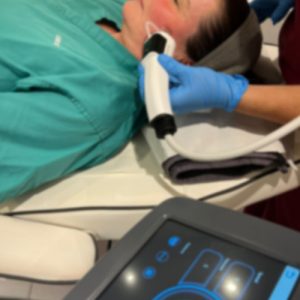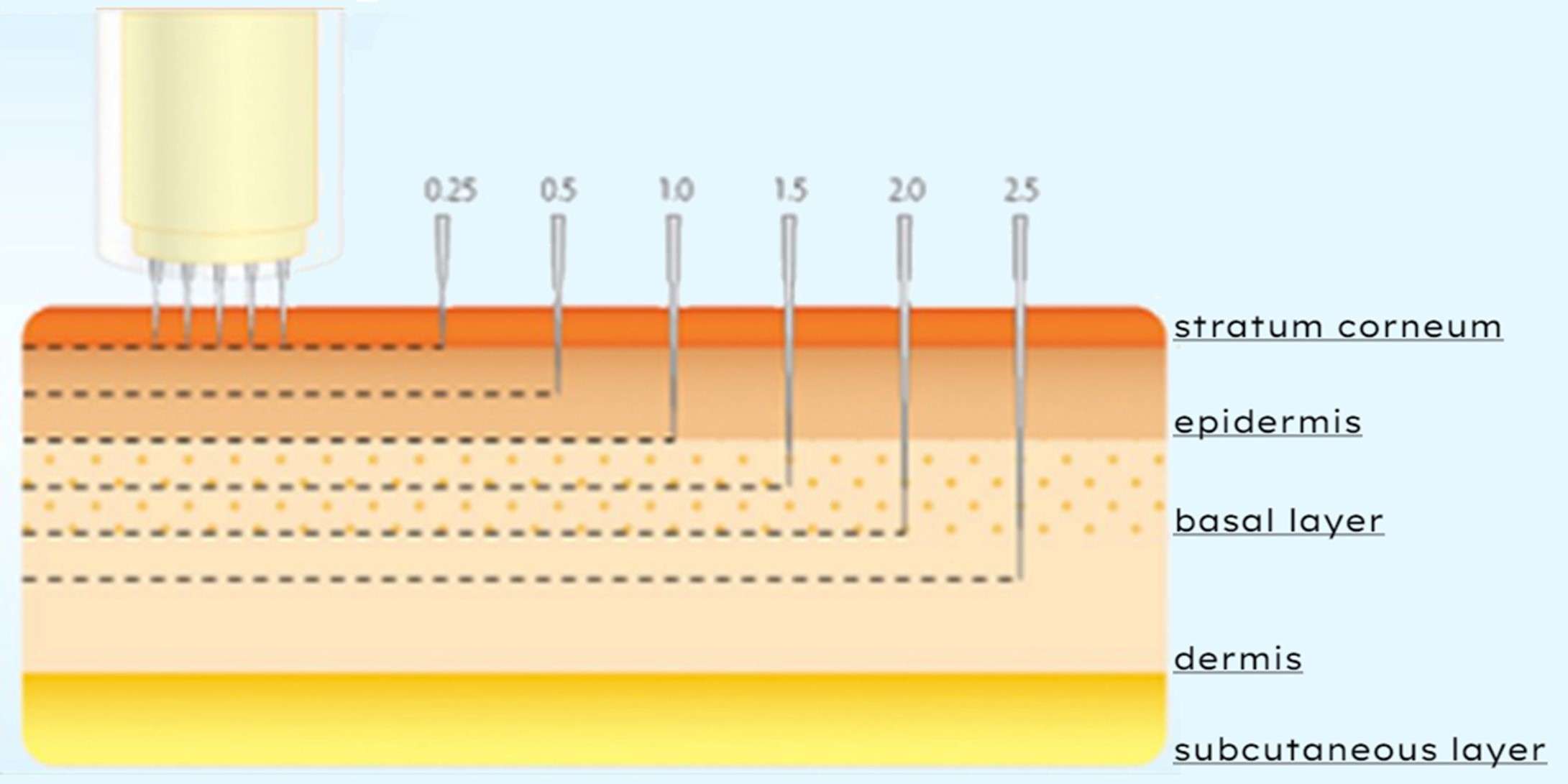Patient Information Leaflet
Fractional Radiofrequency Microneedling

Fractional Radiofrequency Microneedling
If you are considering having Fractional Radiofrequency Microneedling, we recommend that you read the following information. This will help you to be fully prepared, know what questions to ask and what you should expect from your practitioner or therapist. Prior to treatment, you should have a face-to-face consultation with your treating practitioner or therapist and be offered a cooling off period before returning for treatment. This will allow you time to consider your decision carefully based on the information you have been provided with.
Fractional radiofrequency microneedling is an advanced method of skin rejuvenation that encourages collagen production. It stimulates the body’s natural healing process within the dermis, resulting in tighter and more rejuvenated skin. It is the latest innovation that combines micro-needling and radiofrequency technologies, both of which are already well-established as standalone treatments for skin rejuvenation and tightening due to their effects on fibroblasts within the skin. Fibroblasts are responsible for the production and maintenance of the extracellular matrix, the structural and biochemical support for the skin. They produce the structural and adhesive proteins of the skin as well as the space-filling ground substance, ensuring the skin is well nourished, intact, and healthy. Fractional radiofrequency microneedling can be used on multiple sites of the face and body.
Make sure you understand why fractional radiofrequency microneedling may be suitable for you, what you can hope to achieve and any alternative treatment options.
Fractional radiofrequency microneedling is most often performed on the face, but it can be used almost anywhere. Some of the most popular treatment areas include:
- Face
- Brow lifting
- Marionette lines
- Neck and décolleté
- Jowls and jawline
- Abdomen
- Knees
- Stretch marks
Fractional radiofrequency microneedling is particularly popular for the following indications:
- Lines and wrinkles
- Loose and crêpe skin
- Sun damage
- Uneven skin texture
- Stretch marks
- Loss of skin laxity
- Scarring
- Large pores
Make sure that the area and concern are suitable for fractional radiofrequency microneedling.
Radiofrequency energy is delivered to the target area via tiny needles within the applicator handpiece. Some devices apply a vacuum to the skin to ensure better contact and a more precise depth of penetration. The energy intensity and depth can be varied according to the treatment indication and often more than one pass over the skin is performed so that different depths of the epidermis and dermis can be targeted for maximum results. Most devices can target depths between 0.5mm and 4mm, which can treat from the epidermis down to the deep dermis, depending on the area of the face and body.
The radiofrequency energy is deployed through coated or insulated needles to ensure that the heat remains at the correct tissue plane for increased accuracy and safety. Collagen fibres within the skin are heated to 55 – 65 degrees Celsius, stimulating the body’s natural healing processes and the creation of new collagen and elastin fibres and increasing skin cell turnover.

Worn out and damaged collagen is replaced with new collagen, leading to a tightening effect, and the activation of fibroblasts produces other skin proteins and hyaluronic acid, creating a smoother appearance. Due to the action of fractional radiofrequency microneedling in the breakdown of disorganised collagen fibres in scars and stretch marks, these can be improved with treatment, as well as fine lines, wrinkles, loose crêpe skin and overall skin tone. Depending on the skin concern, several treatments may be required, and this should be discussed with your practitioner or therapist beforehand. However, results can vary depending on skin type, age, sex, skin health, area treated and appearance prior to treatment.
Most people only experience minimal discomfort during a fractional radiofrequency microneedling treatment. The needles that are inserted into the skin are very thin and penetrate very quickly, creating only a very mild sting. Some areas of the face and body can be more sensitive, and the settings of the device can be adjusted to allow for this. When the radiofrequency energy is delivered, this can cause a slight warmth to the skin, but it should not feel hot since the heat is generated beneath the surface of the skin and for only an instant. For those with sensitive skin, or find the treatment unpleasant, the settings can be adjusted to make it more tolerable by reducing the depth of injection and the amount of energy applied.
After treatment, the skin may feel warm and appear pink, like the sensation experienced following sun exposure and this generally settles over a few hours.
Different devices do vary slightly on the amount of discomfort experienced during the procedure, depending on the handpiece needles and energy application and some practitioners may recommend the use of a topical or local anaesthetic pre-treatment.
The procedure is minimally invasive and considered safe, with few associated risks, providing a thorough medical history has been taken and considered prior to treatment commencing. The handpieces are single-use and provided in sealed, sterile packets to prevent cross-contamination and infection. Your practitioner or therapist should open the applicator head in front of you and dispose of it in a sharps bin after your treatment.
The skin should be cleaned and disinfected prior to treatment and fractional radiofrequency microneedling should not be used in any area where the skin is infected or inflamed or if cold sores are present as this may lead to a worsening effect or the spread of an infection. It is also safe in darker skin types as the technology does not use light or laser modalities and the risk of post-inflammatory hyperpigmentation is very low.
The treatment creates very small micro-channels in the skin, leaving most of the skin barrier intact and healing is usually quick and without complication.
Side-effects may be more likely due to the following factors:
- Patient factors: Skin condition, lifestyle factors, diet, age, certain medical conditions/medications.
- Practitioner factors: Training, years of experience, number of procedures performed.
- Premises factors: Suitability of the environment with appropriate infection control.
Fractional radiofrequency microneedling has few complications, however no treatment is without risk, and these should be discussed during your consultation.
We recommend that treatments are performed in a suitable clinical environment with sharps disposal.
Possible adverse effects include:
- Pain/Tenderness: You may experience some minor tenderness, discomfort, aching or stinging during and after the procedure. If you do have more pain than expected or advised, it is important to contact your treating practitioner or therapist.
- Redness: Following treatment, it is normal for the skin to appear quite red. This normally settles within a couple of hours but can occasionally persist for longer, particularly with sensitive skin and when treatment settings are high.
- Swelling: Any treatment which causes controlled trauma to the skin or tissues can lead to swelling. Following fractional radiofrequency microneedling, this is rare and if it does occur, it is usually minor and generally settles within a few days.
- Bruising: Due to the suction applied, this can rarely lead to bruising of the skin. Devices with a vacuum applicator usually have a setting to reduce the suction and reduce this risk.
- Herpetic outbreak: In people susceptible to cold sores, microneedling around the mouth area can precipitate an outbreak of cold sores. It is important that this is discussed during the consultation as people who have regular attacks may benefit from medication pre-treatment to prevent this.
- Blood spots/scabbing: Treatment in people with thin skin or those taking medication or over the counter remedies that thin the blood can develop some small red spots where the needles have penetrated the skin which can last for a few days and may develop into some flaking and scabbing.
If you develop any unexpected side-effects after treatment, it is important to contact your practitioner or therapist for a review as soon as possible, as they may be able to offer some corrective treatment. Although your practitioner or therapist may initially contact you by telephone or video call or recommend that you provide photographs, this is not a suitable substitute for a face-to-face review to provide an accurate diagnosis.
Your practitioner or therapist should provide you with an out of hour’s emergency number.
Prior to your treatment you should have a consultation with your practitioner or therapist to explain the procedure, advise on expected results, address your expectations, and discuss alternative treatment options. You should also complete a medical history form and be allowed a cooling off period to enable you to make an informed decision with full disclosure of the possible risks and side effects specific to you. You should also be informed of the cost of the treatment. Before your procedure, you will be required to sign a consent form, this may be on paper or electronic, and be given the opportunity to ask any further questions. Photographs should be taken and kept as part of your medical record and to assess response to treatment. They should not be used for any other purpose without your explicit permission.
Do not feel pressurised or coerced into having treatment at the same time as your consultation.
Before your fractional radiofrequency microneedling treatment, the area will be cleansed and disinfected. If you are having a topical local anaesthetic, this may then be applied and left on the skin for a suitable amount of time. The device settings are adjusted to the appropriate levels for the treatment area and the handpiece is applied to the skin. The practitioner or therapist will usually do a single shot first to check for comfort and skin reaction. If these are acceptable, the area will then be systematically treated by applying multiple shots next to each other to cover the whole area. Several settings may be varied, including depth, radiofrequency energy, vacuum, and speed. The practitioner or therapist may make adjustments when treating more delicate areas, such as the under-eye skin. It is normal to do more than one pass over the entire area to target superficial and deeper layers of the skin for optimum results and the treatment time is usually about 30 minutes or more.
Following the procedure, your practitioner or therapist may apply a moisturiser, serum, or cooling mask as well as a sun protectant as the skin’s natural barrier has been compromised. It is important to continue to use skin care and sun protection as instructed in your aftercare advice.
Often, a small lifting effect is noticed immediately after treatment, but it does take at least 6 weeks to see the result. A course of 1 – 3 sessions, dependent on severity of skin concern, may be required for best results. Treatments are often conducted every 4 weeks, with a maintenance treatment every 6 – 12 months.
It is important to be honest about your medical history, previous aesthetic procedures, skin care products used, and any medication taken so that you can have a safe and effective treatment. As fractional radiofrequency microneedling is only minimally invasive, most people are suitable for this treatment, particularly those who do not want or are precluded from a surgical procedure. However, you may not be suitable if any of the following applies:
- If you are pregnant, breast-feeding, actively trying to conceive, or undergoing IVF.
- If you have eczema, dermatitis, sunburn, or previous radiation therapy in the treatment area.
- If you have certain medical conditions, such as liver or kidney problems, poorly controlled diabetes, blood clotting disorders, cancer (undergoing radiotherapy or chemotherapy), diseases affecting the lymphatic system, poorly controlled epilepsy, or immunosuppression (either medical or drug-related).
- If you are suffering from any skin infection or inflammation in the treatment area.
- If you have ever developed hypertrophic or keloid scars.
- If you are taking Roaccutane or oral steroids or using topical steroids in the treatment area.
- If you are unwell, including coughs and colds, on the day of treatment.
- If you have a pacemaker or metal implant near the site where you are having treatment.
- Body dysmorphia or certain mental illnesses.
- If you are under the age of 18 years.
It is important to be honest about your medical history, previous surgery and any medication taken so that you can have a safe and effective treatment.
- Avoid skincare containing retinols and exfoliants (such as salicylic acid, glycolic acid) pre-treatment.
- Avoid sun exposure, tanning beds and fake tans before and after your procedure for at least 1 week.
- Consider anti-viral medication pre-treatment if you have a history of cold sores.
- Ensure excessive facial hair and beards are clean shaved.
- Avoid applying perfumes or aftershave to the area on the day of treatment.
- Discuss any medical or aesthetic treatments that you are planning with your practitioner or therapist before treatment so these can be taken into consideration.
- If you are unwell on the day of your appointment, contact the practitioner or therapist to reschedule.
- Ensure your practitioner or therapist is informed if there are any changes to your medical history or medication taken before receiving any treatment.
- Do not plan to have treatment within 2 weeks of an important social event or holiday as this may not allow enough time for side-effects to settle or to have a review appointment.
After treatment, most people can resume their normal daily activities although immediately after fractional radiofrequency microneedling, there may be some redness, tenderness and swelling at the treatment site which can last up to 3 days. The skin may also feel dry which can be made more comfortable with the use of a moisturiser and a sun protectant needs to be used.
Many practitioners and therapist advise the following after treatment:
- Use hydrating skincare products, your practitioner or therapist can recommend suitable products.
- Avoid makeup for 24 hours and avoid touching the skin as much as possible.
- Avoid hot, humid conditions, sun exposure and sun beds.
- Ensure you are well hydrated after treatment.
- Avoid saunas, swimming pools and sunbeds until the initial swelling and redness has settled.
Contact your practitioner or therapist if you experience any unwanted side-effects.
Ensure you know the following information:
- Practitioner’s/therapist’s full name
- Practitioner’s/therapist’s profession/qualifications
- Practitioner’s/therapist’s contact details (address, telephone number, and email)
- An emergency contact number in case a complication occurs.
If you are not happy with your treatment outcome, you should attempt to resolve this with your treating practitioner or therapist in the first instance. If you need to see a different person, you are entitled to receive a copy of your treatment record outlining the treatment area, device used, and settings, to have your concerns addressed safely. However, remedial treatment may not always be possible. Sometimes it may be necessary to allow time for the side-effects to wear off. Practitioners and therapists are legally required to have indemnity insurance in place for all the treatments they perform which you can confirm at your initial consultation.
The ACE Group World patient leaflets have been produced to give you some ideas of what the treatment involves, possible side effects, what you should expect and what you should ask.
Patient Leaflets
Purchase Patient Information Leaflets to use in your own practice.

Comments are closed.